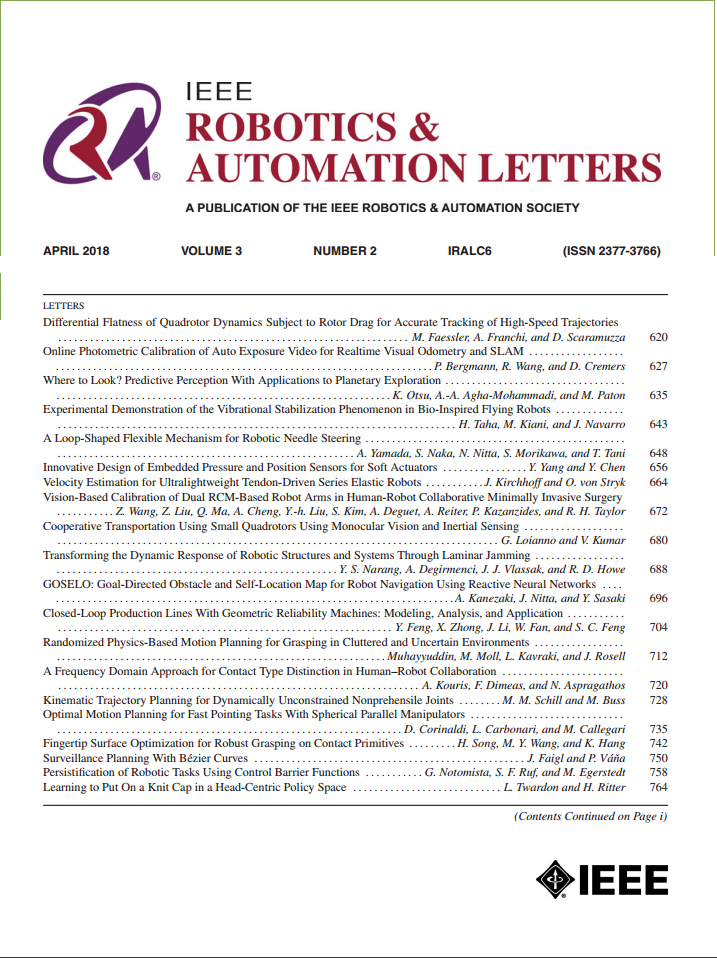基于自适应逐块区域生长的深度图像高效平面分割
IF 4.6
2区 计算机科学
Q2 ROBOTICS
引用次数: 0
摘要
平面分割算法广泛应用于机器人领域,在室内定位、场景理解和机器人操作等场景中发挥着关键作用。这些应用通常需要实时、精确和鲁棒的平面分割处理,这提出了重大挑战。现有的基于像素或固定大小的补丁操作的方法是多余的,因为现实场景中的平面区域大小不一。本文介绍了一种高效的平面分割方法,即自适应斑块区域生长(APRG)。APRG从数据采样开始,构建数据金字塔。为了避免在大平面区域中出现冗余的平面拟合,我们引入了一种自适应补片平面拟合算法,该算法采用自顶向下的方式访问金字塔。在此过程中获得了尽可能大的平面斑块。随后,我们介绍了一种专门为我们的补丁表示设计的区域增长算法。总体而言,在不使用并行加速技术的情况下,APRG在640x480分辨率下在中程CPU上实现了600帧以上的FPS,其性能比最先进的方法高出1.46倍。此外,除了在运行时加速之外,APRG显著提高了分割质量,特别是在真实数据上。本文章由计算机程序翻译,如有差异,请以英文原文为准。
Efficient Plane Segmentation in Depth Image Based on Adaptive Patch-Wise Region Growing
Plane segmentation algorithms are widely used in robotics, serving key roles in scenarios such as indoor localization, scene understanding, and robotic manipulation. These applications typically require real-time, precise, and robust plane segmentation processing, which presents a significant challenge. Existing methods based on pixel-wise or fix-sized patch-wise operation are redundant, as planar regions in real-world scenes are of diverse sizes. In this paper, we introduce a highly efficient method for plane segmentation, namely Adaptive Patch-wise Region Growing (APRG). APRG begins with data sampling to construct a data pyramid. To avoid redundant planer fitting in large planar regions, we introduce an adaptive patch-wise plane fitting algorithm with the pyramid accessed in a top-down manner. The largest possible planar patches are obtained in this process. Subsequently we introduce a region growing algorithm specially designed for our patch representation. Overall, APRG achieves more than 600 FPS at a 640x480 resolution on a mid-range CPU without using parallel acceleration techniques, which outperforms the state-of-the-art method by a factor of 1.46. Besides, in addition to its speedup in run-time, APRG significantly improves the segmentation quality, especially on real-world data.
求助全文
通过发布文献求助,成功后即可免费获取论文全文。
去求助
来源期刊

IEEE Robotics and Automation Letters
Computer Science-Computer Science Applications
CiteScore
9.60
自引率
15.40%
发文量
1428
期刊介绍:
The scope of this journal is to publish peer-reviewed articles that provide a timely and concise account of innovative research ideas and application results, reporting significant theoretical findings and application case studies in areas of robotics and automation.
 求助内容:
求助内容: 应助结果提醒方式:
应助结果提醒方式:


